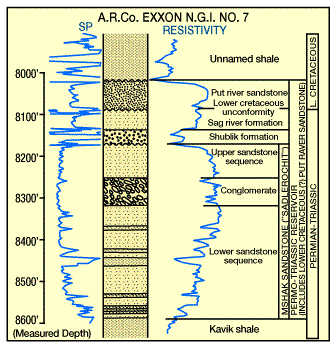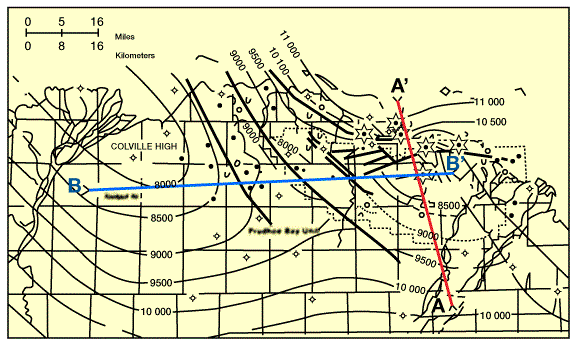Examples
The two field area examples discussed below represent giant accumulations of petroleum (greater than 1 billion bbl), and therefore show the impressive importance this facies has had to oil exploration and development.
Sarir and Messla Fields, Sirte Basin of Northern Libya
The Sarir and Messla fields lie on the southeastern edge of the Sirte embayment of Libya.(Figure 1, Location of Sirte basin and its major oil fields.) Both are giant fields, with oil reserves of 3 and 12 billion bbl in place respectively (Gillespie and Sanford 1967).

the reservoir is the lower Cretaceous Sarir sandstone, which includes a variety of nonmarine facies, but is dominated by braided alluvial deposits. It contains several units that are truncated by an unconformity and onlapped by an Upper Cretaceous group of shales, marls, and limestones (Rakb Group), which have acted as both the source and, to some degree, the seal of the petroleum accumulations.
Porosity in both fields is not primary, but the result of fracturing induced by rift tectonism, which created the basin. There is an average of two fractures per foot, as determined from core sampling, and porosities average about 18% to 20%. Permeabilities average several hundred millidarcies, but intervals of as much as 2 to 3 darcies occur. The main factor contributing to the giant size of these fields, however, is the thick and continuous nature of the braided alluvial reservoir sands.
The Messla field is an unconformity trap in which the Sarir sands are truncated against Precambrian basement. (Figure 2, Cross section of Messla field with sample log of the productive Sarir Group braided alluvial deposit.) It has a gross pay thickness of 90 ft and is about 375 km2 in aerial extent.

The Sarir field is more complex, being a combination trap determined by both the mentioned unconformity and a block-faulted anticlinal structure.
(Figure 3, Cross section of Sarir field, showing truncation of braided alluvium and other continental deposits by a major unconformity).

In size, the producing area is somewhat larger (about 420 km2) than the Messla field, and its oil column is considerably thicker (300 ft).
Prudhoe Bay
The well-known Prudhoe Bay field of Alaska’s North Slope is another example of a giant field whose major reservoir is a braided river sand capped by an unconformity and transgressive marine sediments. Though somewhat similar, the specific setting is more complex than at Messla and Sarir. A thick section of Late Paleozoic to Jurassic-age deposits were deformed and uplifted along a rising basement high in Late Cretaceous time.
Subsequent marine incursion buried the erosional surface, against which were truncated all older formations, including the Permo-Triassic Sadlerochit sandstone, a coarse, pebbly, crossbedded, braided alluvial deposit. Trapping in the Sadlerochit is, as at Sarir, due to truncation at the updip truncation on an anticlinal limb beneath the unconformity and against a normal fault. Figure 4 (SP and resistivity log of the Permo-Triassic reservoir interval in a productive Prudhoe Bay well) gives the log and lithologic profile seen in a producing well.

Figure 5 (Structure contour map of the producing sandstone at Prudhoe Bay.

Star symbols indicate successful wells in the Permo-Triassic. Faulting is simplified; contours are in feet.) reveals the general complexity of the field Prediscovery seismic data was of excellent quality. (Figure 6, North-south seismic section through the discovery well at Prudhoe Bay.

Note the detail of interpretation possible on this section. Updip truncation of the Permo-Triassic section against the unconformity is clearly seen.) Clearly seen were the updip wedge-out of the potential reservoir formation, as well as its specific structural setting. As a consequence, the discovery well was ideally located right at the crest of the Prudhoe Bay structure, and penetrated more than 400 ft of gas cap before encountering oil.
Reservoir properties are truly excellent, with 20% to 25% porosity and permeabilities ranging from 300 md up to 3 darcies. Estimated original recoverable reserves were 9.6 billion bbl of oil and 26 tcf of natural gas.
Recommended for You
Classification of Nonmarine Sandstones
The Principles of Geosteering | Geosteering Best Practices
 Petro Shine The Place for Oil and Gas Professionals.
Petro Shine The Place for Oil and Gas Professionals.



